There are many leadership styles to choose from, and we will take you through twelve of the most common leadership styles and help you find which leadership styles to use and which leadership styles you should absolutely avoid. I have used all my experience as a CEO and a wealth of theoretical knowledge to select these leadership styles. Make sure you pick your leadership styles wisely and on purpose, and do not simply use the leadership styles that come naturally to you without consideration. I will show you how to do this in this article.
What is a leadership style?
A leadership style is a process by which a leader seeks the participation of followers to reach the goals of their organization. Different leadership styles fit different situations, purposes, and people, meaning that great leaders switch between multiple leadership styles.
Try our Lewin leadership styles test (new tab) to see if you are an autocratic, democratic, or laissez-faire leader.
Which are the 12 Common Leadership styles?
These are the 12 common leadership styles:
- Democratic Leadership Style
- Laissez faire Leadership Style
- Autocratic Leadership Style
- Servant Leadership Style
- Visionary Leadership Style
- Transformational Leadership Style
- Transactional Leadership Style
- Coaching Leadership Style
- Pacesetting Leadership Style
- Bureaucratic Leadership Style
- Affiliative Leadership Style
- Charismatic Leadership Style
Each of these leadership styles will be explained further, together with their advantages and disadvantages, together with links for further reading in this article and a thorough guide to help you decide which leadership styles you should use.
1. Democratic Leadership Style
We have reached one of the most popular, engaging, and effective leadership styles. If you consider yourself a leader, you must learn and master the democratic leadership style to a level where you can enjoy its advantages while limiting and controlling its disadvantages. Sadly, a lot of autocratic leaders are unlikely to be open-minded enough to make it work.
What is the Democratic Leadership Style?
Democratic leadership builds on empowering team members to participate in decision-making, with a strive toward consensus. The engaging climate welcomes everyone’s opinions, leading to robust solutions. However, the democratic leader still has the final say in any decisions. This style is sometimes slow but generally very effective.
The Democratic Leadership style was introduced in the 1930s as one of the three leadership behaviors used in the Kurt Lewin experiments in 1938. The Lewin model assumes a leader has one of the three behaviors, and there is no push for leaders to switch styles depending on circumstances. (One of the primary reasons I dislike the Lewin models. Learn more here: Criticism of the Lewin Leadership Styles.)
Democratic leadership is so good and useful that it is also included in several modern leadership frameworks, such as the Goleman leadership styles. The Goleman version is defined as a situational style to be used with five other styles. The democratic leadership style is also called participative leadership, and it resembles the Team Leadership Style from the Blake and Mouton Managerial Grid and the participative leadership style of the Situational Leadership Model even more. Last but not least, the participative leadership style of House’s Path-Goal theory is very similar to the democratic leadership style as well.
Here is our video on the democratic leadership style:
Advantages of the Democratic Leadership Style:
- Creativity and innovation are encouraged
- Collaboration creates solid solutions for complex problems
- Employee engagement is high
- Common goals lead to high accountability
Disadvantages of the Democratic Leadership Style:
- Collaborative decision-making is time-consuming
- Productivity can temporarily decline when awaiting decisions
- It does not work well in low skilled, inexperienced teams
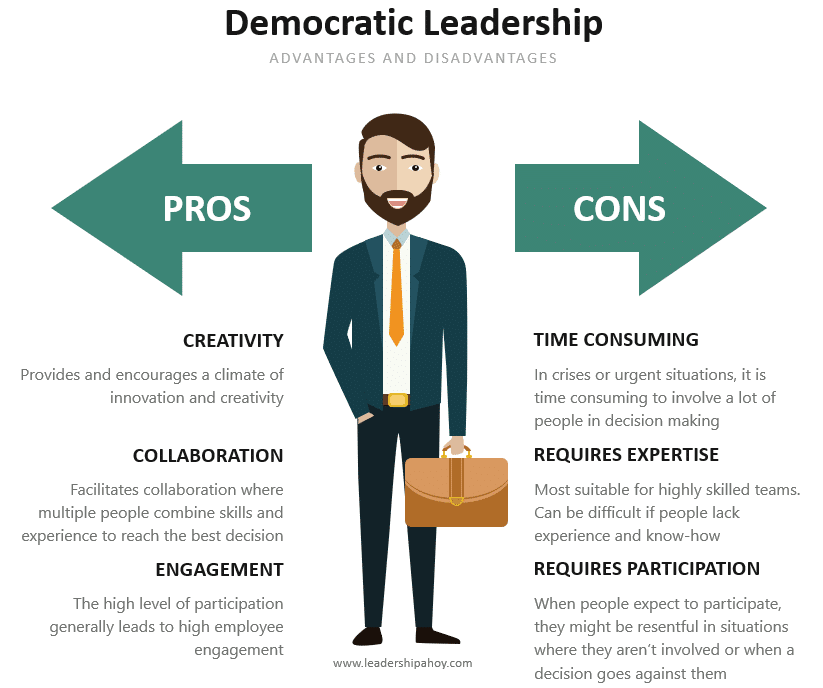
If you are serious about taking your leadership to the next level and boosting your career, check out the democratic leadership course I have created for you, it is loaded with tips and tricks that I use in my job as a CEO. You can also learn more about the mechanisms and success factors of this leadership style in our complete Democratic Leadership style article or some subtopics here: Examples of Democratic Leadership and How can Democratic Leadership be Effective. Try our Lewin leadership styles test (new tab) to see if you are an autocratic, democratic, or laissez-faire leader.
2. Laissez faire Leadership Style
Sometimes a leader needs to back off a bit and let employees handle things on their own. That is not laissez-faire; that is just empowering others. Just because you avoid micromanaging, it does not mean you are a laissez-faire leader. Do avoid the laissez-faire leadership style and bear in mind that it is sometimes referred to as “the absence of leadership”.
What is the Laissez-Faire Leadership Style?
Laissez-faire leadership is a hands-off leadership style where team members are free to make all decisions. Laissez-faire leadership leads to low productivity and a perception of a disengaged leader. Laissez-faire leadership can work with highly-skilled, capable, and self-motivated teams.

Laissez-Faire is the opposite of autocratic leadership and was also part of the Kurt Lewin leadership styles, just like the autocratic leadership style. Furthermore, it is part of the Full Range Leadership Model together with transformational and transactional leadership. Laissez-faire leadership is also known as hands-off leadership, free-rein leadership, the absence of leadership, or simply zero leadership.
Advantages of the Laissez-Faire Leadership Style:
- A highly skilled and experienced team can do great when making all the decisions themselves
- Team members get an abundance of creative freedom
Disadvantages of the Laissez-Faire Leadership Style:
- Teams lacking the right maturity level can quickly fall apart
- The leader is seen as uncaring or absent, leading to lower engagement and motivation
- It can lead to confusion and often to drops in productivity
Do not use the laissez-faire leadership style! What is the purpose of a leader who doesn’t lead? Even at times when the leader needs to back off, there are alternate ways of leading that can provide good impact, such as the coaching or visionary leadership style, to name two examples. I have experienced a laissez-faire boss, and he completely lacked inspiration and could neither coach me nor provide me with an overarching purpose. Purpose and inspiration could have propelled my performance and career further.
More information describing this style, how to recognize laissez-faire leaders and why you must avoid it is available in our article on the Laissez-Faire Leadership style. Try our Lewin leadership styles test (new tab) to see if you are an autocratic, democratic, or laissez-faire leader.
3. Autocratic Leadership Style
The autocratic leader is sadly too common even these days. The Autocratic leader is the typical despotic “Boss” who has the “My way or the highway” approach. Unfortunately, the internet is flooded with articles making this style sound like a legitimate choice when nothing could be further from the truth. Good leaders are not autocratic leaders.
Autocratic leadership is when the leader holds all the decision power and rarely consults others. Autocratic leadership is unpopular, has many disadvantages, and leads to low engagement and sometimes to a toxic environment. Autocratic leadership is useful in a crisis when control and fast decisions are crucial.
Autocratic leaders have been around for a long time in the shape of tyrants, dictators, monarchs, etc. Still, the Autocratic Leadership Style, or rather leadership behavior, is first mentioned by Kurt Lewin et al. in their 1938 leadership experiment. The autocratic style is not defined as interchangeable, i.e., a leader is either an autocratic leader, a democratic leader, or a laissez-faire leader, with no switching, no situation dependency. It is simply the personality of the leader, a behavioural leadership style.
Advantages of the Autocratic Leadership Style:
- High clarity on structure, roles, and expectations
- Quick decision making and improved crisis handling, with the right autocratic leader, that is
- Can lead to increased productivity in low-skilled environments, at least temporarily
Disadvantages of the Autocratic Leadership Style:
- There is a lack of empowerment in the team, which leads to low engagement and accountability
- Too strong dependency on the leader; after all, if only the leader can make decisions, not much happens without the leader’s involvement
- Intimidation, punishment, or threats are common ways of ensuring obedience. This is, of course, not sustainable and can lead to a toxic work climate
Although the autocratic leadership style is generally disliked, it has a place, and that’s in times of crisis when difficult decisions need to be taken fast; but then it is actually referred to as the commanding leadership style, which is a modernized and better version. The autocratic leadership style can also be useful in organizations where motivation is lacking; the autocratic leader can push through for results anyway. Studies have found that specific types of personalities prefer being led by an autocratic leader, which I have experienced personally several times in my role as a CEO.

Do not become an autocratic leader! There are lots of reasons why you should absolutely avoid being an autocratic leader, so be very careful with this one, even if it is the typically strong and powerful leader we often see in movies.
For a full and more complete description of the autocratic leadership style, how to recognize it in others, and why you simply must avoid it, click here: Autocratic Leadership Style. (Try our Lewin leadership styles test (new tab) to see if you are an autocratic, democratic, or laissez-faire leader.) You can also learn of Produce-or-perish leadership, also called Authority Obedience Leadership which is the version of autocratic leadership in the Blake-Mouton Managerial Grid.
4. Servant Leadership Style
The well-known Servant leadership style sticks out from the rest of the styles in this list. Despite being relatively modern, it does not build on a situational approach involving the switching between leadership styles, but instead stays with a strict focus on servant leadership in a framework separate from all others.
What is the Servant Leadership Style?
Servant Leadership focuses on improving people, society, and organizations. In Servant Leadership, the leader serves others, which leads to strong ethics, and engaged, motivated employees. However, a Servant leader with too much focus on serving others can lose track of organizational goals and purpose.
The Servant leadership style was first defined in 1970 by Robert K. Greenleaf in an essay where he outlined that there were two types of leaders: Servant-First and Leader-First. The first type focuses on the success of others, and the second type cares more about themselves and their personal success. Servant leadership stands out and is difficult to compare with the other styles, but transformational leadership comes the closest in my mind.
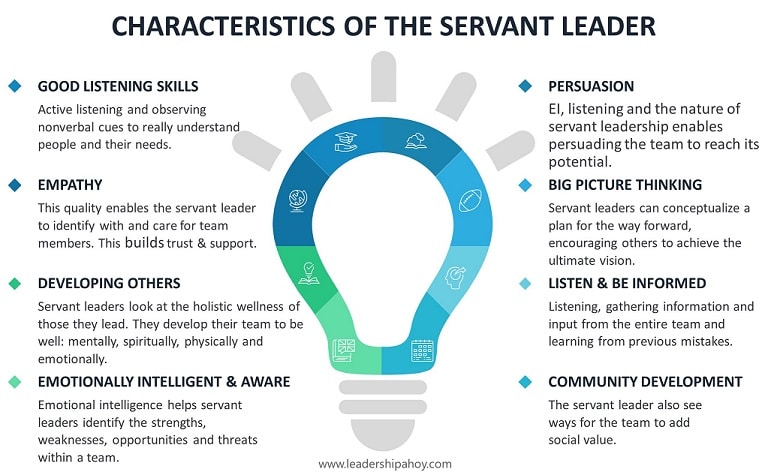
Advantages of the Servant Leadership Style:
- Participation and a common cause lead to high engagement
- Strong ethical behavior
Disadvantages of the Servant Leadership Style:
- It does not work for all companies and organizations since an overarching cause is at the core of servant leadership
- True servant leaders are challenging to find since they need to have a complete lack of ego
- Business and organizational goals might be lost in the struggle for the long-term cause
In my experience, many people who see themselves as Servant Leaders, aren’t really servant leaders. I personally think you are better off with a situational leadership model such as the Goleman styles combined with some strong ethical leadership. Don’t become an additional example of a leader who misunderstands the servant leadership concept. Read more about this style and what it really entails in our article on the Servant Leadership style.
Here is our video on the Servant Leadership Style:
5. Visionary Leadership Style
The Visionary leadership style is one of the best leadership styles available today, also proven by research. I incorporate Visionary leadership in my job as a CEO as often as I can, and the benefits are extraordinary when done right. (Get inspired by my article on The importance of Visionary Leadership.)
What is the Visionary Leadership Style?
Visionary Leadership is when a leader inspires others to pursue a long-term vision. The Visionary Leadership style builds on participation, communication, and goal setting. A visionary leader risks tunnel vision and losing short-term focus since all efforts are focused on the long-term results.

The Visionary Leadership style is also known as the authoritative leadership style and is one of the six leadership styles introduced by Daniel Goleman in 2000. (Join our newsletter and get some of my secret tips for each of the Goleman leadership styles.) It has substantial similarities with transformational leadership and some similarities with charismatic and servant leadership. Furthermore, visionary leadership was found to have the most substantial positive impact on organizational climate in Goleman’s research.
Here is our video on the visionary leadership style:
Advantages of the Visionary Leadership Style:
- A clear vision creates motivation, inspiration, and unity among team members
- Innovation and creativity thrive under visionary leadership
- Strong awareness of change drivers in the surrounding world increases the chance of successful adaption by the organization
Disadvantages of the Visionary Leadership Style:
- The strong emphasis on the long-term can lead to overlooking short-term and operational matters
- If the vision becomes too intertwined with the personality of the leader, it can turn into charismatic leadership, which has substantial adverse effects
Take the opportunity to learn more about this great style in our in-depth article, which teaches you how to create a compelling vision and how to communicate it properly to your organization and stakeholders: the Visionary Leadership style.
6. Transformational Leadership Style
Transformational leadership is one of the most well-known and popular leadership styles available, for good reasons, I might add, and many articles have been written on the subject.
What is the Transformational Leadership Style?
Transformational leadership creates substantial change for team members as well as organizations. Expectations, aspirations, perceptions, and values are transformed into something better. Transformational leadership develops team members and motivates and inspires them to reach extraordinary success. (Many similarities with the aforementioned Visionary Leadership Style. Read a comparison here: Transformational vs. Visionary Leadership.)

Transformational leadership was first defined by James MacGregor Burns in the late 70s as part of Full Range Leadership. Bass and Avolio developed transformational leadership and the Full Range Leadership Model further in subsequent years. The transformational leadership style compares well to a combination of democratic, visionary, and coaching leadership among the six leadership styles by Goleman. Transformational leadership also has some commonalities with Servant leadership.
Advantages of the Transformational Leadership Style:
- It is excellent for change management and growth
- High transparency and strong communication build participation and engagement
- The shared vision results in inspiration, motivation, and collaboration
Disadvantages of the Transformational Leadership Style:
- Transformational leadership can be very time consuming and long term
- It does not work well without a strong change element or vision
- It can result in too much risk-taking and overlooking short-term requirements
The transformational leadership style is great, and the structured approach enables you to add different elements at a time, depending on the situation and maturity of your team or organization. I have used this approach as a CEO successfully in a major company turnaround, and it really works.
Want to know more? Read our in-depth article, which shows you how to establish transformational leadership and how to become a truly transformational leader (the complete transformational leadership style article), or more specific focus articles such as Transformational Leadership Examples or Transformational vs. Servant leadership.
7. Transactional Leadership Style
Transactional leadership can be seen as the more autocratic and less visionary sibling of transformational leadership.
What is the Transactional Leadership Style?
Transactional leadership is built on a clear structure of reward and punishment for different levels of performance. It is focused on results, efficiency, and performance rather than people and relationships. Transactional leadership is often seen as the opposite of transformational leadership.
Transactional leadership is an expansion of the bureaucratic leadership style, and it was conceptualized by Burns together with the transformational leadership style. The two styles were seen as mutually exclusive until Bass and Avolio developed the model further, adding that a leader can use both styles as appropriate while also adding Laissez-Faire to the mix, forming Full Range leadership. Transactional leadership has three different maturity levels or approaches: Active management by exception, passive management by exception, and contingent reward.
Advantages of the Transactional Leadership Style:
- There is a clear connection between performance and rewards
- It can be very productive, especially when it comes to short-term results
- Clear order, structure, and rules, enabling repetition and swift onboarding of new team members
Disadvantages of the Transactional Leadership Style:
- The sole focus on performance can be demotivating and disengaging
- Rewards have a limited impact on peoples performance; at some point, other factors start to matter more
- The strict structure hampers creativity and innovation

If you aspire to become a transformational leader, you need to understand and know when to also apply some transactional leadership and when to avoid it. I have seen some bad implementations of this style during my career as a CEO, but also some good ones, so it does have a place. Read more in our detailed article on this style which shows you how to effectively use transactional leadership: the transactional leadership style. Some topical reading is also available: Transformational vs. transactional leadership, and Transactional Leadership: Contingent Reward.
8. Coaching Leadership Style
Why would coaching be restricted to the world of sports? All leaders who desire performance should spend some time developing their team members, and the coaching leadership style is perfect for that, making it one of my favorites.
What is the Coaching Leadership Style?
Coaching leadership focuses on improving employees to become better individuals and professionals with the leader as a coach. A Coaching leader can sacrifice initial performance for learning opportunities. Coaching leadership is very effective in the long term but can be difficult and time-consuming.
Here is our video on the Coaching Leadership Style
Coaching Leadership was coined by Daniel Goleman in 2000 and is part of his six leadership styles based on emotional intelligence. (Join our newsletter and get some of my secret tips for each of the Goleman leadership styles.) There are streaks of coaching leadership within the transformational leadership style, but besides that, it is rather unique among leadership styles.

Advantages of the Coaching Leadership Style:
- It leads to high engagement and low turnover within the team
- It develops people to perform more and better in the future
- Coaching builds empowerment and confidence in people
Disadvantages of the Coaching Leadership Style:
- Coaching is difficult and time-consuming
- Coaching requires commitment from both parties
As a CEO, I have used this style successfully several times over my career. It has helped me to mentor people further down in the organization, growing and developing our management team, as well as getting some of my direct reports enough development to become my peers. Read about some Coaching Leadership Examples and improve your leadership by learning more about how and when to coach in our article on the coaching leadership style. There is also a coaching leadership style in the Situational Leadership model, although sometimes referred to as selling leadership.
9. Pacesetting Leadership Style
I think many business leaders, including myself, lean toward pacesetting. This is because Pacesetting leadership creates visible results quickly. Achieving results fast can lead to early promotion, resulting in pacesetting leaders moving up in the hierarchy. In all honesty, I think my pacesetting streak really helped me to reach my CEO position.
What is the Pacesetting Leadership Style?
Pacesetting leadership is when the leader sets an example of high performance, pace, and quality. Team members are expected to follow suit, and the pacesetting leader values result the most. Pacesetting leadership is good for reaching short-term targets but is detrimental to long-term employee engagement.

The pacesetting leadership style is one of the six leadership styles in the Daniel Goleman model of 2000. It has a very strong task orientation, with a low focus on people since it is all about getting the job done. Pacesetting is very different from commanding or autocratic leadership since it is about setting a high-performing example for others to follow rather than ordering people around expecting immediate obedience. The Pacesetting leadership style is very similar to the Achievement-Oriented leadership style, which belongs to House’s Path-Goal theory and has similarities with visionary leadership as well.
If you are serious about mastering this style, you should check out our offer here: Pacesetting Leadership – A CEO’s Blueprint.
Here is our video on the Pacesetting Leadership Style:
Advantages of the Pacesetting Leadership Style:
- It can substantially increase performance for a limited time
- Short bursts of increased performance build team confidence and commitment, as long as it is not too often
Disadvantages of the Pacesetting Leadership Style:
- Overuse leads to stressed team members with low engagement
- The focus on performance leads to a poor level of people focus, meaning a lack of coaching and development of individuals

Although some pacesetting leadership can do magic, you must not overdo it since it can destroy your team in the long run. As with all leadership styles, it is about applying the right dose and frequency of pacesetting leadership. You can learn more about how to do this properly in our in-depth article on the Pacesetting Leadership style. (Join our newsletter and get some of my secret tips for each of the Goleman leadership styles.)
10. Bureaucratic Leadership Style
Bureaucratic leadership was called rational-legal leadership at its inception in the 1920s. Rational principles built on laws, rules, and regulations are the foundation of bureaucracies. In turn, bureaucracies themselves have enabled central governing and larger national agencies, a cornerstone of building society.
What is the Bureaucratic Leadership Style?
Bureaucratic leadership is characterized by rigid rules, high standardization, and stiff division of labor. Bureaucratic leadership works best in organizations where regulations and standards are of great importance. Bureaucratic leadership hampers change, creativity, competition, and development.
Bureaucratic leadership, or as rational-legal leadership as it was called back then, was one of the three types of authority defined by Max Weber in the 1920s, together with traditional leadership and charismatic leadership. Traditional leadership describes monarchs, kings, emperors, and similar leaders with the right to lead through culture, birthright, etc., which tells you how outdated this original model really is.

Advantages of the Bureaucratic Leadership Style:
- Clear definition of roles, expectations, processes, and tasks
- Enables adherence to strict rules, allowing objective judgment
- Drives efficiency through specialization and transaction volume
Disadvantages of the Bureaucratic Leadership Style:
- The reliance on rules limits creativity and innovation
- Slow and poor adaptation to change due to structural rigidness
- Competition and collaboration suffer due to the high specialization and silo structure
Although some elements of bureaucracy are needed in most modern organizations, do not make it your leadership style since that would mean going over the top. A bureaucratic platform in an organization does not mean bureaucratic leadership. Read more in our detailed article: the Bureaucratic Leadership style.
11. Affiliative Leadership Style
A good leader knows to care about the team members and is not afraid to show it. A confident and strong leader is also ok with sharing feelings and thoughts with others without considering it a display of weakness. A leader who desires an open and trusting dialogue needs to start by being honest and setting the stage for that dialogue.
What is the Affiliative Leadership Style?
Affiliative leadership is completely focused on the people and relationships in an organization. The leader’s primary task is to ensure harmony and friendship in the workplace. This leads to happy employees but can, at the same time, lead to poor performance.
The Affiliative Leadership Style is one of the six leadership styles by Goleman, which are based on Emotional Intelligence. Overly focusing on Affiliative Leadership compares well to Country Club Leadership, which is worth avoiding since it can lead to becoming best friends with your employees, leading to reduced expectations in the long run. However, the most striking similarities are probably compared to the supportive leadership style of the Path-Goal theory, which focuses on employee well-being, reduction of stress, social satisfaction, etc.
Here is our video on the Affiliative Leadership style:
Advantages of the Affiliative Leadership Style:
- The team feels that the leader genuinely cares about them, which builds loyalty, commitment, and trust
- Positive communication and strong people focus
- Strong bonds between members help in collaboration and crisis handling
Disadvantages of the Affiliative Leadership Style:
- Underperformance might be accepted (Country Club Leadership)
- The focus on harmony can result in avoidance of conflict and critical feedback
- The overall goal might be lost, and the strive for harmony may take over
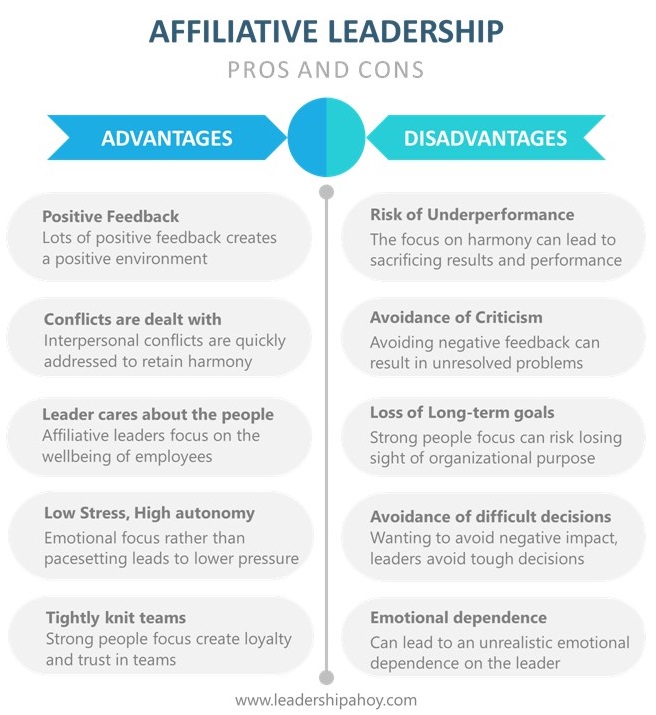
I have developed my affiliative leadership in my capacity as a CEO, and it became extremely valuable during the pandemic when leading remotely became the norm. (Here are some examples of the Affiliative leadership style in the workplace.) Learn the elements of affiliative leadership and how far you should go with this style in our in-depth article on this style here: the Affiliative Leadership style.
12. Charismatic Leadership Style
The Charismatic Leadership Style is not just about being charismatic as a person and a leader. It is all about charisma and not much else.
What is the Charismatic Leadership Style?
Charismatic leadership is based on the leader’s personal charisma to a very high degree. Charismatic leadership can be very inspirational and motivational, leading to unity and engagement. Charismatic leaders risk becoming autocratic one-man shows, which can lead to manipulation, bad deeds, and disasters.
Charismatic leadership forms the three types of authority, as defined by Max Weber in the 1930s, together with traditional and bureaucratic leadership.
Advantages of the Charismatic Leadership Style:
- Inspirational and unifying
- Builds strong commitment and purpose among the followers
- Can help deliver a long-term plan, or even a “cause”
Disadvantages of the Charismatic Leadership Style:
- The complete dependency on the personal characteristics of the leader makes succession planning difficult
- Risks becoming a cult where the leader stands above everyone else, perhaps even above society and laws
- The high expectance of obedience limits transparency, creativity, and innovation

Feel free to use your personal charisma. There are many reasons for a leader to do so, but don’t make it your leadership style. Provide vision and purpose through the visionary leadership style instead, and put your charisma to good use in communication, coaching leadership, and affiliative leadership as well.
Read more about the severe limitations and the dark side of charismatic leadership in our subject article: the Charismatic Leadership style, and compare it with other styles here:
How to pick your leadership styles?
We have now reached the second chapter and will take you through how to pick your leadership styles. We start out with a set of questions to acquaint you with the selection process.
Which leadership style should I use?
You should never choose one single leadership style to rely on as a leader. You should select multiple leadership styles to form a toolbox with different leadership styles for different situations, people, and purposes.
All right, let us rephrase the question, then.
Which leadership styles should I use in my leadership?
You should use different leadership styles depending on the situations you encounter, so consider the typical situations you lead in, your environment, team members, and other circumstances and select different leadership styles capable of addressing those situations and factors.
Which leadership styles fit together?
Many leadership styles are combined frameworks or toolboxes, such as the Goleman leadership styles, the Full Range leadership model, the Lewin leadership styles, and Situational Leadership. These models combine different leadership styles to form toolboxes based on research, theory, and practice.
Why go through a personal selection process when you can use a prepared leadership styles toolbox and adapt and finetune it to meet your personal leadership situation? I will now take you through some of these leadership styles models briefly so you understand what is already readily available.
There are many different collections or subsets of leadership styles. Historically, it started with the nowadays rather irrelevant Great Man Theory, which led to the Trait Theory of leadership underlining which personal characteristics leaders need to have, but not expanding into tools and methodology such as leadership styles. As Behavioral Leadership theories emerged, the actions of the leader came into focus. This includes theories such as the Lewin styles, the Ohio State University Leadership Study, the Michigan State Leadership Research, and Blake and Mouton’s Management Grid. These leadership approaches focused on the outcome of a leaders personal behavior, but did not originally include the dimension of a leader actively selecting how to lead for certain reasons. Essentially, it was about how the leader behaved as a person, not about the attitudes and methods the leader chose to use. Some of the models even concretely concluded that a leader cannot change his or her behavior but that “we are who we are”. In the 1960s, this started to come, driven by the contingency theory of leadership that stipulates that a leader should adapt his or her methods and behaviors depending on the circumstances and the intended impact. These theories include Fiedler’s contingency leadership theory, House’s Path-Goal Theory, and the Vroom and Jago leadership model.
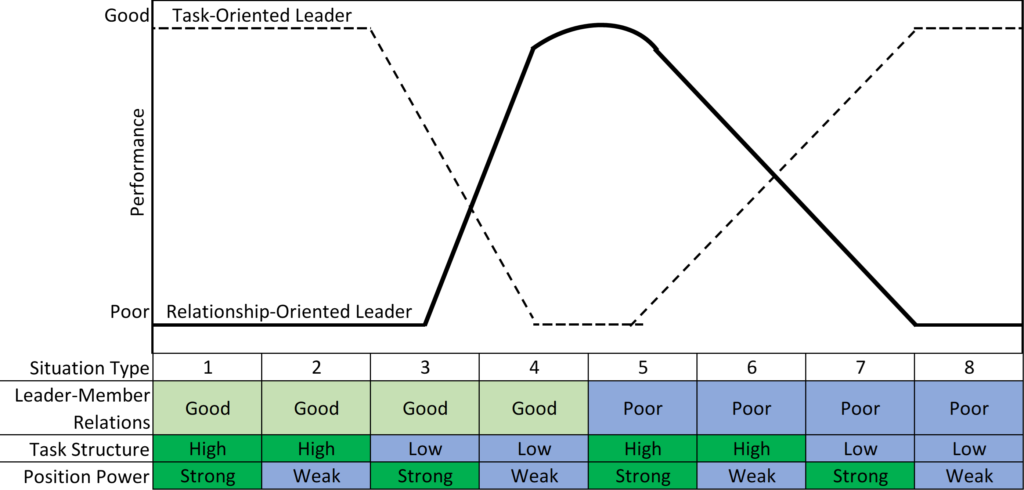
Feel free to use the image as long as you link back to this page.
Here is a video on the Fiedler model:
More modern approaches focus on identifying proper leadership styles, defining them, explaining when they should be used, and basically building a full toolbox for leaders to use., as well as the Full Range Leadership Model. These are the great toolboxes we shall focus on and explain to you a bit better. They are the Six Leaderships styles by Goleman, the Full Range Leadership Model (transformational leadership), and the Situational Leadership Model. In order to keep this article brief, you will get an overview introduction, and I do urge you to read the full in-depth articles that I link to for deeper knowledge.
1. Leadership Styles Toolbox 1: The Full Range Leadership Model
The Full Range Leadership Model provides any leader with a good range of leadership styles. In my experience as a CEO, the Full Range Leadership Model is one of the sharpest and most useful leadership styles toolboxes available today. The Full Range Leadership Model, or FRLM, is also backed by substantial research, unlike some other frameworks. Before we go into the explanation of the Full Range Leadership Model, let us present a few overview answers.
The Full Range Leadership Model (FRLM) is a complete approach to leadership styles that covers low to high engagement, leading to different leadership efficiency. FRLM was defined by Bass and Avolio, building on works by Burns, and includes laissez-faire, transactional, and transformational leadership.
The three leadership styles lead to different levels of Efficiency and Engagement. Laissez-Faire leadership is the worst, Transactional Leadership leads to medium levels, and Transformational Leadership leads to strong efficiency and high engagement, so there is a concrete layout of this leadership styles toolbox for you to use and grow your leadership following a path.
Remember the three styles, as described earlier in this article:
- The Laissez-faire leadership style is hands-off or even “the absence of leadership”,
- The Transactional leadership style is built on a clear structure of reward and punishment for different levels of performance. It is focused on results, efficiency, and performance rather than people and relationships.
- The Transformational leadership style creates substantial change for team members as well as organizations. Transformational leadership is people-focused and develops the team members and motivates and inspires them to reach extraordinary success.
The Full Range Leadership Model is an excellent approach to leadership that I encourage you to learn and use. I personally use the six leadership styles by Daniel Goleman, which I feel lead to a similar impact and has an equally wide approach but builds more on six tools to combine in different proportions, rather than the more sequential approach of the Full Range Leadership Model.
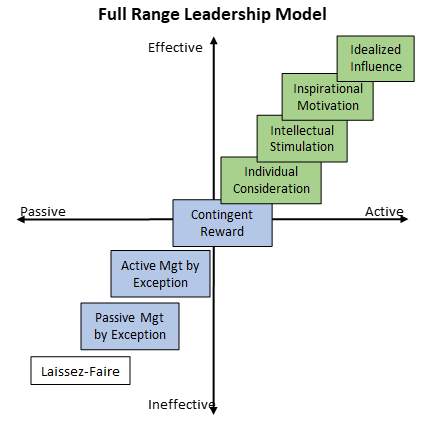
To master Full Range Leadership, you need to learn the three leadership styles and the components they contain. You need to consider your situation and job at hand and decide which component fits the best for the circumstances, the people, and your own capabilities. Constantly revisit this and move up and down the scale in the chart above, making entire leaps when needed. Do keep in mind that you might need to adapt several times a day and consider different parts of your organization. In some transactional environments, such as a warehouse, the full transformational aspects might not always be needed or possible, where more transactional components can apply. At the same time, and in the same company, the research and development department and the marketing department might need advanced transformational leadership to function. Just like a carpenter does not only use a hammer the entire day, you as a leader must learn to use different tools for different areas, jobs, people, and impact.
Please continue to read about the other leadership styles toolboxes before you make up your mind by scrolling further down in this article. If FRLM is the toolbox you select in the end, read more in the following articles here at leadershipahoy.com to learn more about it, with examples, advantages, disadvantages, and my experience of these leadership styles in my CEO career:
- Contingency theory of leadership
- The Full Range Leadership Model, a theoretical explanation
- The Laissez-Faire Leadership Style: Descriptions, pros/cons, examples from a CEO career
- The Transformational Leadership Style: Definition, pros/cons, CEO experiences
- The Transactional Leadership Style: Explained by a CEO, with examples, pros, cons, etc.
- Comparison articles: Transformational leadership vs transactional, Transformational vs visionary leadership, Autocratic vs transformational leadership, Servant vs transformational leadership, Democratic compared to Transformational leadership, charismatic vs transformational leadership.
2. Leadership Styles Toolbox 2: The Six Leadership Styles by Goleman
Now fast forward from the Full Range Leadership Model to the year 2000 and Daniel Goleman’s article in the Harvard Business review describing a set of six leadership styles. The Goleman leadership styles based on Resonant Leadership and emotional intelligence are my absolute favorites, and I use them every day in my job as a CEO of a multinational company. I actually created a step-by-step democratic leadership course containing all my tips and tricks for those of you who want to implement democratic leadership and improve your career chances through better leadership and improved business results.
Here is a video on Resonant Leadership:
Goleman underlines that leadership style is a strategic choice and instead of finding one style that fits you, you should try to use the optimum leadership style for the situation at hand. The strategic choice would mean purposely selecting which style to use and not being reactive to situations in a spontaneous and emotional way. Goleman identifies six different leadership styles using emotional intelligence in different ways and to different degrees. (Join our newsletter and get some of my secret tips for each of the Goleman leadership styles.) As Daniel Goleman puts it himself: “The best leaders don’t know just one style of leadership – they’re skilled at several, and have the flexibility to switch between styles as the circumstances dictate.”

According to this entire framework, emotional intelligence is one of the first and single most important parts of leadership. To lead, you as a leader must understand the emotional sides of different aspects as well as the emotions of the people you lead. For the team to believe you, understand you, and be willing to follow you, there needs to be some basic rapport and emotional understanding. Emotional Intelligence builds on self-awareness, self-management, social awareness, and relationship management. Regardless of which leadership styles toolbox you select, you will most definitely improve as a leader by sharpening your emotional intelligence and applying it in a better way.
Once the leader knows how to apply emotional intelligence, resonant leadership should be the target state. Resonant leadership is the ability of a leader to create a positive emotional impact using Emotional Intelligence. Resonant leadership imprints positive and energetic emotions and puts people in emotional synch. Successful implementation of resonant leadership in a team results in emotional comfort, cooperation, idea sharing, and strong emotional bonds that help the team through difficult times.
In short, using your emotional intelligence and the six leadership styles by Goleman results in resonant leadership when done right. The importance and impact of all this have been thoroughly proven by research, and I can attest that it actually works. I have built and nurtured some really strong teams delivering great results and impact while enjoying the work, much thanks to implementing the six leadership styles by Goleman.
The six leadership styles by Daniel Goleman are:
- Commanding leadership style (a.k.a Coercive or Directive)
- Visionary leadership style
- Affiliative leadership style
- Democratic leadership style (a.k.a participative leadership style)
- Pacesetting leadership style
- Coaching leadership style
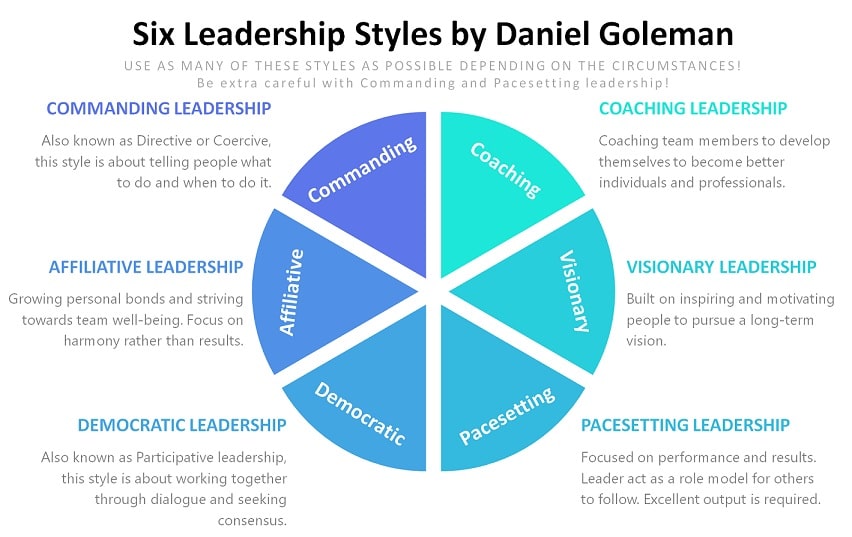
Remember that the whole concept builds on using as many of these leadership styles as possible depending on the circumstances, such as the situation, people involved, the topic at hand, and other factors. Remember the leadership styles described further above in this article:
- Commanding Leadership Style means that the leader makes all the decisions and gives orders to his or her team. Tight control and follow-up combined with high clarity in rules, roles, and expectations are core parts of this leadership style which can result in micromanagement, stress, and toxic climates.
- The Visionary Leadership Style builds on the big picture and sets a long-term path for the organization. Communicating and marketing the purpose and vision is central.
- The Affiliative Leadership Style focuses on relationships and people. This style leads to trust and harmony in the team but can also reduce performance and accountability.
- The Democratic leadership style is when an empowered team takes full part in the decision-making process, although the leader approves or makes the decision in the end. (Become an expert by taking our democratic leadership course.)
- The Pacesetting leadership style has a complete focus on performance and results. Leading by example is more of a “follow me – let’s overachieve” rather than bullying others to work harder.
- The Coaching leadership style is when the leader coaches team members to develop themselves in the long term to become better individuals and professionals.
I switch between these styles constantly in my leadership. (Join our newsletter and get some of my secret tips for each of the Goleman leadership styles.) I can be commanding in a meeting about a compliance incident in the morning, provide a vision for a strategy workshop by lunch, be affiliative with an employee under pressure during a short phone call, use democratic leadership in the afternoon management team huddle, and pace set our logistics organization before the evening. I did, of course, coach one of the sales managers on a development topic during the day as well.
Here is a video on the entire Goleman leadership styles framework:
Please continue reading about the next Toolbox, but feel free to access our articles related to the Goleman leadership styles here at leadershipahoy.com:
- Commanding leadership style (a.k.a Coercive or Directive)
- Visionary leadership style
- Affiliative leadership style
- Democratic leadership style (a.k.a participative leadership style)
- Pacesetting leadership style
- Coaching leadership style
3. Leadership Styles Toolbox 3: The Situational Leadership Model
The Situational Leadership Model is the third leadership styles toolbox worthy of this list. This model is thought to be the leadership model that is perfect for every situation. A Situational leader works assiduously to create meaningful connections with team members. Ultimately, the team receives leadership with the necessary leadership style to fit the organization’s current situation.
In 1982, Dr. Paul Hersey and Dr. Ken Blanchard published their book “Management of Organizational Behaviour: Utilizing Human Resources”. They probably didn’t realize that this book would help them become world-renowned leadership experts. The central theme of their message was a new approach to leadership, one based on relationship-building and leadership adjustment. This new approach was dubbed the Situational Leadership Model (www.situational.com).
The simplest way to describe situational leadership in general vs. behavioral approaches (Ohio State Leadership Studies, for example) to leadership is to think about the daily complexities of a corporate work environment. Managers are dealing with teams filled with people who have diverse needs, skills, and interests. Using a one-size-fits-all approach to leading such a team means that there will be performance issues, dissatisfaction, and tension. In contrast, a manager who adjusts his or her leadership style to suit each team member’s needs and the unique needs of the organization can get teams functioning optimally. This type of manager is a situational leader, and the Situational Leadership Model is one of several situational approaches to leadership. (Fiedler’s Contingency Theory and the Six Leadership styles based on Emotional Intelligence are two other situational theories. The links lead to our in-depth articles on those theories.)
The Situational Leadership Model has the following elements or aspects:
- Two Leadership Behaviors: Relationship Behavior and Task Behavior
- Four Leadership Styles: Telling, Selling, Participating, and Delegating Leadership Styles, which consist of different doses of the two leadership behaviors
- Follower readiness or maturity, describing their competency, confidence, and commitment
- Four different situations, S1 to S4, with different characteristics and needs that the leader needs to handle appropriately
Depending on the maturity and readiness of the team, a leadership style is selected.

The four leadership styles of the Situational Leadership Model are:
- The Telling Leadership Style involves high amounts of task behavior and low amounts of relationship behavior, making it similar to the commanding leadership style by Goleman.
- The Selling Leadership Style, with high amounts of task behavior and relationship behavior, has a lot of commonalities with the coaching leadership style.
- The Participating Leadership Style, with low task and high relationship behavior, is very similar to the democratic leadership style by Goleman.
- The Delegating Leadership Style resembles the Visionary leadership style with a low amount of task focus and low amount of relationship behavior
All in all, the leadership styles of the situational leadership model can be seen as a subset of the Goleman six, which also contains pacesetting and affiliative leadership. The situational leadership model does a really good job at defining team maturity and readiness, thereby making leaders’ situational assessments somewhat easier.
Do keep on reading for the next chapter on finding out which leadership styles toolbox fits you the best. Here are also some examples on articles connected to the situational leadership model here at leadershipahoy.com
Which leadership styles toolbox fits you the best?
In order to weigh some differences and pros and cons between these three toolboxes, I created this overview table. I explain the scoring further below.
| Number of Leadership Styles | Complexity | Definition of situations | Scientific approach | Flexibility | |
| Full Range Leadership Model | 3, but with subdivision into 8 | High | Low | High | Medium |
| Six Leadership Styles by Goleman | 6 | Low | Low | High | High |
| The Situational Leadership Model | 4 | Medium | High | High | Low |
1. Number of Leadership Styles
The Six Leadership Styles by Goleman obviously has six styles, and the situational leadership model has four styles. The Full Range Leadership Model, however, can be seen as having either three styles, or, if adding the components, eight styles. (Three versions of transactional leadership styles, and four versions of transformational leadership styles, and then adding laissez-faire.)
2. The complexity of the Leadership Styles Toolbox
The more leadership styles you add, the more versatile the model, but the complexity also risks increasing at the same time. Using all eight styles in FRLM means you need to figure out when each of the components is most applicable. However, you can also see it as always striving to reach a new height in components, moving from Laissez-Faire leadership style all the way up to the Idealized Influence component of the transformational leadership style. In my experience, I would not stick to that approach since not all parts of the organization need Idealized Influence, and establishing it would not necessarily be a good return on investment for all the time and resources spent reaching that state. If you are then back to using the different leadership styles of the Full Range Leadership Model at different times in different areas, cherry-picking and using several of them, you need to fully understand which component to use. Realizing if Intellectual Stimulation or Active Management by Exception is the right one is not always as straightforward as you might think.
In this aspect, the Goleman Six are simpler since the names of the leadership styles give you a fast understanding of which one to use when. Although the same applies to the situational leadership model’s four leadership styles, they have a more definite situation of usage, making situational assessment a bit more complex. As your team grows larger and with people of different readiness levels, experience, and maturity, it becomes a bit more difficult to overview the complete situation and which leadership style to use. The simplicity of the Goleman toolbox means that you pick what is needed in your current situation depending on the people involved in it, which makes it more tactical than the situational leadership model, in my experience.

3. Definition of situations for leadership styles selection
The situational leadership model is by far the toolbox putting the most effort into defining actual situations of the three toolboxes. If your team is homogenous enough when it comes to experience and readiness, then the defined situations make it rather easy for the leader to match the appropriate leadership style. The Full Range Leadership Model and it’s very detailed definition of the eight leadership styles also enables close situational matching, but the complexity makes it difficult to use on the fly, tactically, depending on how your week is developing. FRLM and the situational leadership model seem to be more strategic in my mind rather than tactical.
When it comes to the Goleman leadership styles toolbox, the situations are not defined in detail, but if the leader knows what the desired impact is, what the problem is, and what people are involved, picking one leadership style or a mix of a few can be done fast and on the fly. When truly strategic situations emerge, commanding and pacesetting leadership styles are undesirable, and coaching might be too individual, leaving democratic, affiliative, and visionary leadership styles to work with.
4. The scientific approach to the leadership styles
All the models can show plenty of research and wide practical usage of the leadership styles they include, so there are no major differences there.
5. The flexibility of the leadership styles toolbox
If you shoot for the full development of FRLM, meaning you desire an end state of Idealized Influence transformational leadership, you need to work long-term. Quickly switching between states or levels of transactional or transformational leadership can cause confusion and disorganization, meaning that the flexibility becomes a bit lower.
The Situational Leadership model has, in my mind, even lower flexibility since it does not really intend for leaders to switch between styles on a regular basis but rather to develop the maturity of the team in the medium or long term, which of course, is a good thing. Alternating between styles depending on the team member you work with can be tricky, and managing a team with six mature and ready members and two who are new requires a mixed approach.

By learning, practicing, and experiencing success and failure, I have learned that the Goleman six leadership styles are the most flexible approach to leadership, at least for me. The intention of using as many styles as possible means that the leader is not pushed into a corner with few options at hand and different mixes of styles can be used in different situations with powerful results. I use many of the leadership styles every day in my job as a CEO, and I use all of them except the commanding leadership style on a weekly basis. Discussions can be more pacesetting for people who need that in their current situation, less so for ones who need an affiliative approach, and the democratic, visionary, and affiliative leadership styles combined can be used for most meetings and group discussions. Reminding yourself to use all the styles means you look for opportunities to insert coaching leadership as often as you can, remaining at the right level of affiliative, and including others in decisions as required through the use of the democratic leadership style.
All be it that this comparison is subjective to a degree, I prefer using the six leadership styles by Goleman, based on the strong element of Emotional Intelligence (also in FRLM, by the way) and the fact that they have helped me succeed in leading others over the last fifteen years.
Further developing your leadership styles
Regardless of which leadership styles you pick and use, make sure you consider these simple guidelines.
How to become great at leadership styles:
- Never depend on one single leadership style
- Use specific leadership styles on purpose, not because of your personality
- Always assess the situation, circumstances, and people involved before
- Never stop developing yourself: Learn the theories inside out, try things, obtain feedback, reflect, and conclude what works and what does not
If you are motivated to become the best leader you can possibly be, regardless of whether you formally are a manager, not a manager, or desire to become one, keep learning. Start out by taking my democratic leadership course, which helps you to facilitate, instill creativity, empower others, create accountability, define joint visions and targets, and build great teams. All this is based on theory as well as years of practical experience in leadership that I have accumulated in various management capacities, including my time as a CEO of a multinational company. Besides taking the democratic leadership course, I suggest the following reading here at leadershipahoy.com.
- Learn how to create your own leadership development plan and start building it as soon as possible.
- Take our democratic leadership course to empower your team with accountability, innovation and strong performance as a result.
- Try our Lewin leadership styles test (new tab) to see if you are an autocratic, democratic, or laissez-faire leader.
- Read more about the leadership styles and frameworks, including the following:
- Books, books, and books as you can get your hands on them as well, of course
Selected references for this article and the deep-dive articles it builds on:
Primal Leadership, (Ad, Amazon) by Daniel Goleman, Richard Boyatzis, and Annie McKee
http://www.mchnutritionpartners.ucla.edu/sites/default/files/images/HBRLeadershipGetsResults1.pdf
https://online.stu.edu/articles/education/democratic-participative-leadership.aspx#definition
https://journals.sagepub.com/doi/abs/10.1177/104649640003100603
“A Handbook of Leadership Styles”, Cambridge Scholars Publishing
Lewin, Kurt, Patterns of Aggressive behavior in experimentally created social climates. Journal of Social Psychology, 10:2 (1939:May) (https://tu-dresden.de/mn/psychologie/ipep/lehrlern/ressourcen/dateien/lehre/lehramt/lehrveranstaltungen/Lehrer_Schueler_Interaktion_SS_2011/Lewin_1939_original.pdf?lang=en)
https://online.stu.edu/articles/education/what-is-transformational-leadership.aspx#benefitshttps://www.langston.edu/sites/default/files/basic-content-files/TransformationalLeadership.pdf
https://online.stu.edu/articles/education/what-is-transactional-leadership.aspx
“Full Range Leadership Development”, Bruce J. Avolio
Full Range Leadership, Jeanne M. Holm Center https://www3.nd.edu/~jthomp19/AS300/1_Fall%20Semester/27%20Sep/Full_Range_Leadership_V1.pdf
Millenial workers prefer transformational leaders, Becket Frith, Hr Magazine (hrmagazine.co.uk)
Situational Leadership is a registered trademark, refer to www.situational.com for more information.
https://www.kenblanchard.com/Products-Services/Situational-Leadership-II
https://medicine.hofstra.edu/pdf/faculty/facdev/facdev-clinical-blanchard.pdf
https://com-peds-pulmonary.sites.medinfo.ufl.edu/files/2014/01/Hanke-Situational-Leadership.pdf
https://online.stu.edu/articles/education/what-is-situational-leadership.aspx
https://www.strategy-business.com/article/li00042?pg=all
https://www.researchgate.net/publication/323394174_Situational_Leadership_and_Its_Effectiveness_in_Rising_Employee_Productivity_A_Study_on_North_Lebanon_Organization#references




